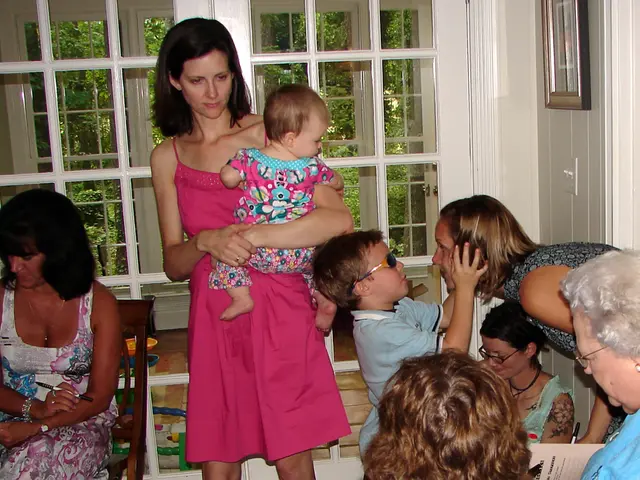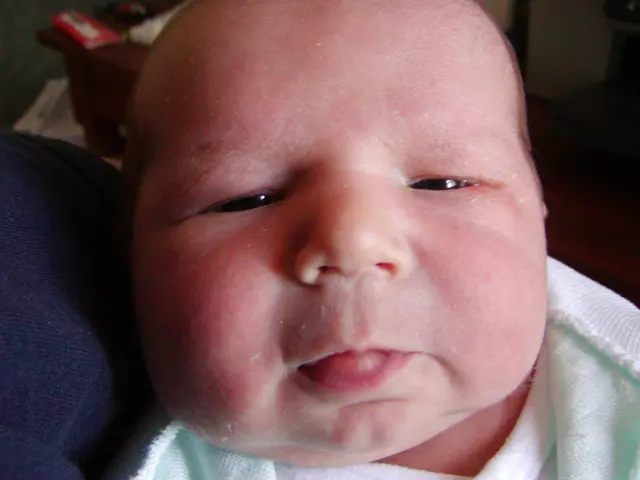Sharing a Bed with Your Infant: Essential Safety Measures
Sleeping with your little one right beside you can be a magical experience, bringing you closer, simplifying those late-night feedings, and providing a sense of comfort. But how close is too close? We've got some guidelines to ensure you sleep soundly... and safely.
First things first, let's clear up some terms. Co-sleeping, or room-sharing, means baby snoozes in their own safe sleep space, like a crib or bassinet, within your room. Bed-sharing, on the other hand, is when you all catch some Zzzs in the same bed. Quite a difference!
Co-sleeping is favored by the American Academy of Pediatrics, as it may reduce the risk of Sudden Infant Death Syndrome (SIDS) by up to 50%. Pediatrician and breastfeeding specialist Dr. Heidi Szugye agrees it's a "nicer alternative to bed-sharing," allowing for closeness and baby's individual needs.
The convenience of bed-sharing might be tempting, but the American Academy of Pediatrics advises against it due to the increased risk of sleep-related infant death under certain circumstances. Rolling onto or squashing the baby, using unsafe bedding, and the risk of falling out of bed are all potential hazards.
Even with these dangers in mind, cultural practices and emotional ties can make warnings against bed-sharing controversial. As a parent, you may choose to co-sleep despite knowing the risks, or find yourself accidentally snoozing with your little one while nursing. Dr. Szugye believes it's essential to understand the factors influencing SIDS risk.
If you do choose to co-sleep, follow these safe sleep practices:
- Opt for Co-Sleeping Over Bed-Sharing: Although bed-sharing might seem appealing, creating a hazard-free sleep environment that adheres to the Academy of Breastfeeding Medicine's guidelines is challenging. Many infants are bottle-fed or formula-fed, and these stringent guidelines don't usually fit the typical American sleep environment.
- Choose a Proper Sleep Environment: The baby sleep market is booming, but not all products are safe. Government safety standards may not apply to older products or hand-me-downs. Avoid inclined sleepers, travel or compact bassinets, in-bed sleepers (bassinets meant for your bed), sidecars, hammocks, swings and bouncers, older cribs, and any products with missing parts or lead paint. Stick with new, modern cribs, bassinets, portable cribs, or play yards that meet safety standards. Check CPSC.gov for recalls on older products.
- Keep the Bed Bare: Cute blankets, stuffed animals, and toys might be inviting, but they have no place in your baby's bed. Keep their sleeping area free from all soft items, like blankets, loose sheets, pillows, toys, and crib bumpers. Only fitted sheets designed for the mattress are acceptable.
- Put Baby to Sleep on Their Back: Sleeping on their back minimizes the risk of SIDS. If baby rolls onto their belly, it's alright as long as they can roll back on their own. Stop swaddling once baby starts rolling.
- Maintain a Comfortable Temperature: Keep the room at a comfortable temperature. Baby's bodies aren't great at regulating temperature, so they can get too hot or too cold more quickly. Dress them in no more than one extra layer than you wear to ensure they stay cozy. You can test the temperature by touching their chest.
- Remember: Safety First! Keep monitorin' and adjustin' to ensure your baby sleeps safely and soundly beside you. Bonding with them while they sleep can create wonderful memories, and a good night's sleep is just what we both need!
- Co-sleeping, as recommended by the American Academy of Pediatrics, can reduce the risk of Sudden Infant Death Syndrome (SIDS) by up to 50%, providing a safer alternative to bed-sharing.
- A parent may choose to co-sleep, even if aware of the risks, as cultural practices and emotional ties can make bed-sharing controversial in certain societies.
- If you decide to co-sleep, it's crucial to follow safe sleep practices such as keeping the bed bare, putting baby to sleep on their back, maintaining a comfortable temperature, and choosing a proper sleep environment from modern, safety-compliant cribs, bassinets, or play yards.
- Parents often find themselves nursing their baby to sleep, which might lead to unintentional bed-sharing, emphasizing the importance of understanding factors influencing SIDS risk.
- Ensuring a safe sleeping environment for your little one can help reduce the risk of sleep-related infant death, allowing both parent and child to get the restful sleep they need for overall health and wellness, including mental health and parenting.








